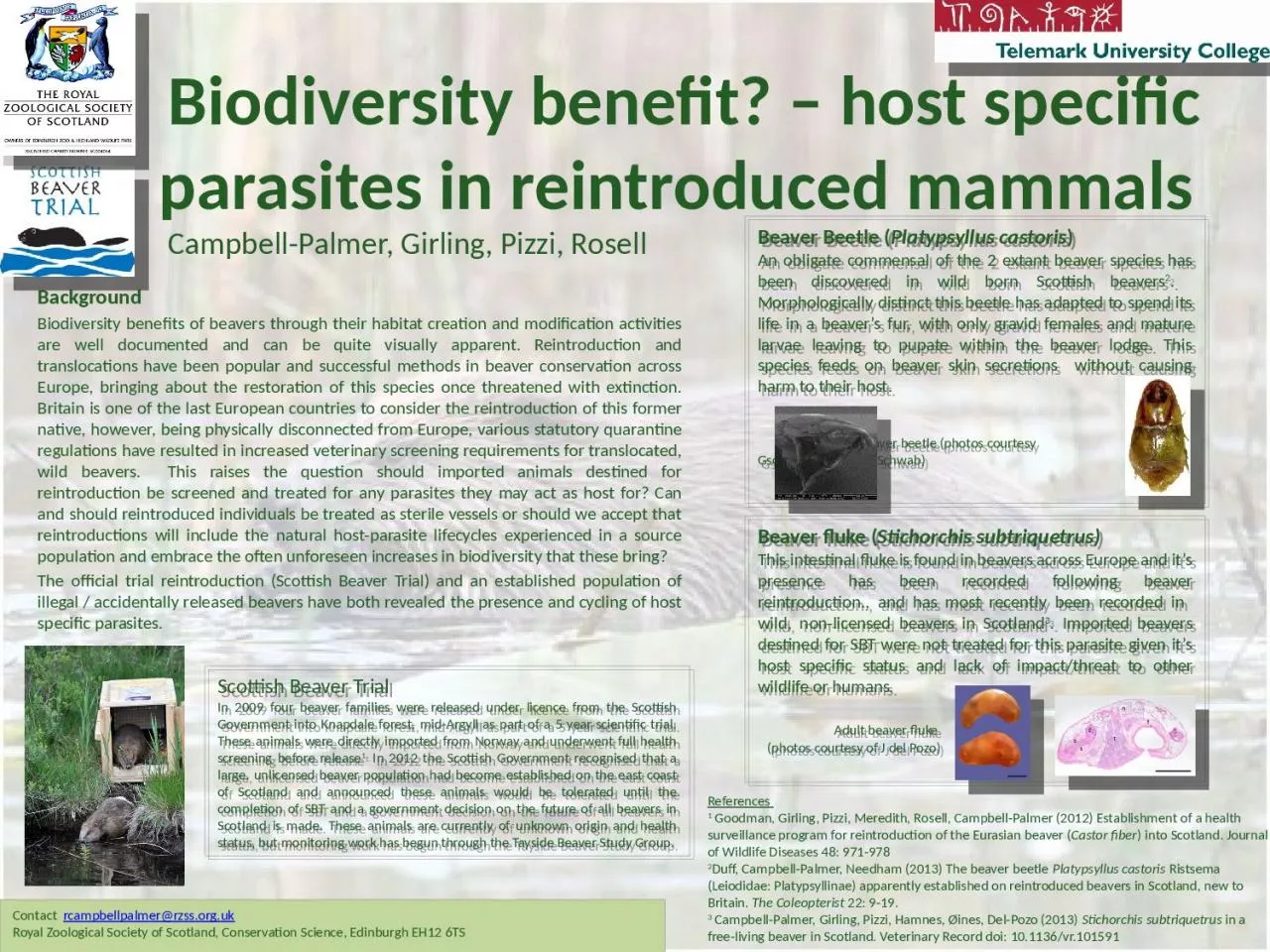

Background Biodiversity benefits of beavers through their habitat creation and modification activities are well documented and can be quite visually apparent Reintroduction and translocations have been popular and successful methods in beaver conservation across Europe ID: 1044437
Download Presentation The PPT/PDF document "Biodiversity benefit? – host specific ..." is the property of its rightful owner. Permission is granted to download and print the materials on this web site for personal, non-commercial use only, and to display it on your personal computer provided you do not modify the materials and that you retain all copyright notices contained in the materials. By downloading content from our website, you accept the terms of this agreement.
1. Biodiversity benefit? – host specific parasites in reintroduced mammals BackgroundBiodiversity benefits of beavers through their habitat creation and modification activities are well documented and can be quite visually apparent. Reintroduction and translocations have been popular and successful methods in beaver conservation across Europe, bringing about the restoration of this species once threatened with extinction. Britain is one of the last European countries to consider the reintroduction of this former native, however, being physically disconnected from Europe, various statutory quarantine regulations have resulted in increased veterinary screening requirements for translocated, wild beavers. This raises the question should imported animals destined for reintroduction be screened and treated for any parasites they may act as host for? Can and should reintroduced individuals be treated as sterile vessels or should we accept that reintroductions will include the natural host-parasite lifecycles experienced in a source population and embrace the often unforeseen increases in biodiversity that these bring? The official trial reintroduction (Scottish Beaver Trial) and an established population of illegal / accidentally released beavers have both revealed the presence and cycling of host specific parasites..Beaver Beetle (Platypsyllus castoris)An obligate commensal of the 2 extant beaver species has been discovered in wild born Scottish beavers2. Morphologically distinct this beetle has adapted to spend its life in a beaver’s fur, with only gravid females and mature larvae leaving to pupate within the beaver lodge. This species feeds on beaver skin secretions without causing harm to their host. Adult beaver beetle (photos courtesy of S Gschmeissner and G Schwab)Beaver fluke (Stichorchis subtriquetrus)This intestinal fluke is found in beavers across Europe and it’s presence has been recorded following beaver reintroduction., and has most recently been recorded in wild, non-licensed beavers in Scotland3. Imported beavers destined for SBT were not treated for this parasite given it’s host specific status and lack of impact/threat to other wildlife or humans. Adult beaver fluke (photos courtesy of J del Pozo)Campbell-Palmer, Girling, Pizzi, RosellContact rcampbellpalmer@rzss.org.uk Royal Zoological Society of Scotland, Conservation Science, Edinburgh EH12 6TSReferences 1 Goodman, Girling, Pizzi, Meredith, Rosell, Campbell-Palmer (2012) Establishment of a health surveillance program for reintroduction of the Eurasian beaver (Castor fiber) into Scotland. Journal of Wildlife Diseases 48: 971-9782Duff, Campbell-Palmer, Needham (2013) The beaver beetle Platypsyllus castoris Ristsema (Leiodidae: Platypsyllinae) apparently established on reintroduced beavers in Scotland, new to Britain. The Coleopterist 22: 9-19.3 Campbell-Palmer, Girling, Pizzi, Hamnes, Øines, Del-Pozo (2013) Stichorchis subtriquetrus in a free-living beaver in Scotland. Veterinary Record doi: 10.1136/vr.101591Scottish Beaver TrialIn 2009 four beaver families were released under licence from the Scottish Government into Knapdale forest, mid-Argyll as part of a 5 year scientific trial. These animals were directly imported from Norway and underwent full health screening before release1. In 2012 the Scottish Government recognised that a large, unlicensed beaver population had become established on the east coast of Scotland and announced these animals would be tolerated until the completion of SBT and a government decision on the future of all beavers in Scotland is made. These animals are currently of unknown origin and health status, but monitoring work has begun through the Tayside Beaver Study Group.